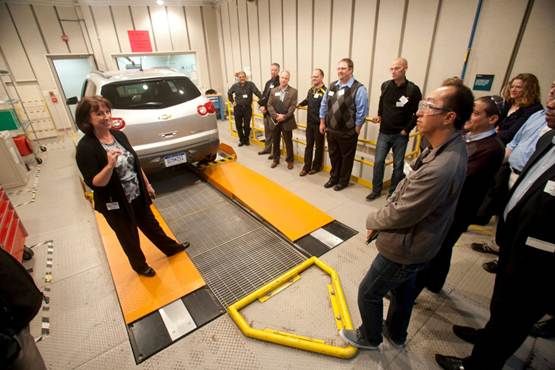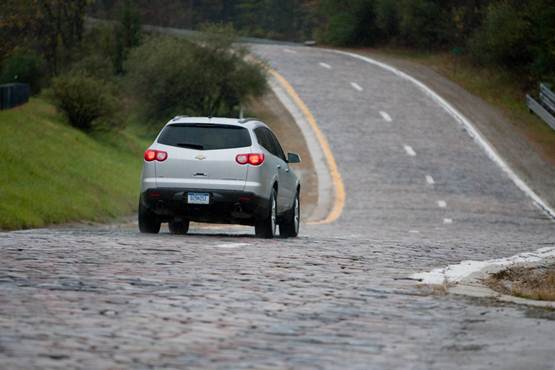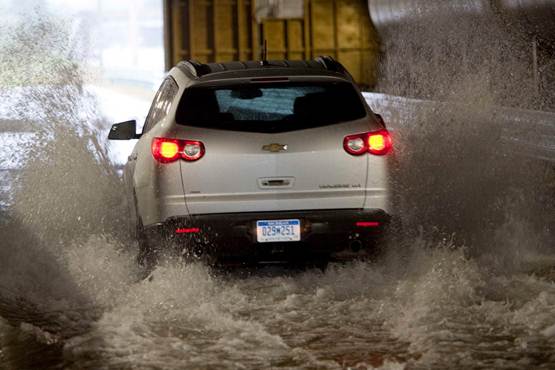- Book Reviews A BETTER WORLD by Sarah Langan
- Book Reviews LIKE HAPPINESS by Ursula Villarreal-Moura
- Book Reviews THE MARS HOUSE by Natasha Pulley
- Book Reviews JADED by Ela Lee
- Book Reviews THE MORNINGSIDE by Téa Obreht
- Book Reviews BABY X by Kira Peikoff
- Book Reviews AFTER ANNIE by Anna Quindlen
- Book Reviews IN ASCENSION by Martin MacInnes
- Book Reviews THE OTHER VALLEY by Scott Alexander Howard
- Book Reviews LEAVE NO TRACE by A.J. Laundau (a writing team of Jon Land and Jeff Ayers)
Ensuring the Quality of the Chevy Traverse
After the soccer game, we walked out to our cars together. My friend reached to open his back hatch and I caught the name of the car before the door swung up: Traverse. “Hey! How do you like your car? I had the chance to learn about the Traverse when I went to Detroit a while ago. What do you think about it?”
You would have thought I asked about his best friend. He told me his Traverse was comfortable, reliable and never disappointed him. He couldn’t say enough good things about it. “I’ve already put 65,000 miles on it and I’ve only had it for about two and a half years!” he exclaimed.
Wow. This guy loved his Chevy Traverse! When I traveled to the GM plant in Detroit, Michigan, I learned exactly why my friend had the right to feel so excited. GM takes tremendous pride in the quality of their cars and use numerous methods to assure every car on the road is the best they can produce.
 During my day with Chevy, I learned about several steps in the quality process. Each car is meticulously tested and re-tested before it’s ever driven by a consumer. I saw their Environmental Squeak and Rattle Simulator and even got to ride in the Traverse as the engineers simulated rough road conditions. This isn’t just your pleasure ride at an amusement park, this simulator can be programmed to simulate exact roads anywhere engineers want a vehicle to be tested.
During my day with Chevy, I learned about several steps in the quality process. Each car is meticulously tested and re-tested before it’s ever driven by a consumer. I saw their Environmental Squeak and Rattle Simulator and even got to ride in the Traverse as the engineers simulated rough road conditions. This isn’t just your pleasure ride at an amusement park, this simulator can be programmed to simulate exact roads anywhere engineers want a vehicle to be tested.
I sat in a 3D simulator that made me feel like I was riding in the Chevy Traverse, but the simulator was located in an intimate conference room. I reached for the steering wheel, even though it wasn’t there. I got a simulated tour of the Traverse from the front to the back and never left my seat. I’d never seen anything like it in my life! Bur this is more than just a fun 3D toy, this highly sophisticated piece of machinery aides engineers and designers in testing the layout, positioning, and design of each element in each car they produce. It’s only one step in Chevy’s intense design process for each car ever made.
Seats are tested for noise by placing them on a shaking device to detect where noises may occur while driving. Magnets were used in the shaking mechanism to ensure the only sounds would come from the item being shaken, not the testing machinery. Seats are also tested for wear, tear, and usability, simulating ten years of wear by a male with a weight in the eighty-fifth percentile. Chevy definitely wants to ensure every consumer will be satisfied with their car for years and years, not just the first few thousand miles.
 After each individual piece is tested for quality, the testing still isn’t over. Cars are driven around the famous Milford Proving Grounds, a short distance away from where we witnessed the other testing devices. Unfortunately for us, the weather was less than pleasant with light rain throughout our time at the proving grounds, but it was great testing-weather for the cars. They were everywhere, driving around to test vehicles in these less-than-perfect conditions.
After each individual piece is tested for quality, the testing still isn’t over. Cars are driven around the famous Milford Proving Grounds, a short distance away from where we witnessed the other testing devices. Unfortunately for us, the weather was less than pleasant with light rain throughout our time at the proving grounds, but it was great testing-weather for the cars. They were everywhere, driving around to test vehicles in these less-than-perfect conditions.
We saw the Traverse drive over a road made entirely of cobble-stones, go through a salt wash, and a splashing chamber. I saw inclines for cars to be tested while driving up grades of varying steepness. We viewed potholes and I rode in the Traverse through several large potholes myself. I was impressed with how well the car moved through this obstacle. I felt the bump, but the car was silent (and now I knew why!) as it got jostled and I barely felt the impact on the pothole.

After all of the extensive testing, the process to ensure quality still isn’t over. Once the testers and engineers have sufficiently tried to break the cars (that’s my wording, not theirs, but that’s what it seemed they were doing), another set of hands are waiting to perform their own quality testing process in the Teardown and Analysis area. This team works through all areas of the vehicle –especially areas the consumer typically doesn’t see –to check for corrosion and wear. Of course, the undercarriage of vehicles is at high risk for rust due to salt and water and this area is inspected carefully. This team examines the entire car carefully to fix any problems they observe. This team leaves no area without inspection to ensure the highest level of quality from all areas of construction.
After my tour of the quality processes for the Chevy Traverse, I felt I knew more details than a lot of consumers out there, but an understanding of quality doesn’t require a tour like I experienced. All that is required is sitting behind the wheel and driving the car for yourself. Once you drive it, you notice GM’s dedication to delivering a quality product in every vehicle. I’m known for my love of cars and wrote about the Chevy Cruze and Chevy Volt in the past. Since I’m cruising around in an eleven year old minivan, I’m always on the lookout for my next car (and hoping to get one soon!). I know the cars from GM are definitely on my short list of ones to check out in the future.
_____________________
When Eileen Calandro isn’t asking her friends about the cars they drive, she is the Chief Mom Connector of Mom Central. You can read about what else she asks her friends about on her personal blog at calandroclan.com and connect with her on Twitter at @MomCentralChat and @calandro5.
Disclosure: Eileen was given an all-expenses paid trip to Detroit to attend the Chevy Traverse event.
-
 A BETTER WORLD by Sarah Langan
A BETTER WORLD by Sarah Langan
-
 LIKE HAPPINESS by Ursula Villarreal-Moura
LIKE HAPPINESS by Ursula Villarreal-Moura
-
 THE MARS HOUSE by Natasha Pulley
THE MARS HOUSE by Natasha Pulley
-
 JADED by Ela Lee
JADED by Ela Lee
-
 THE MORNINGSIDE by Téa Obreht
THE MORNINGSIDE by Téa Obreht
-
 BABY X by Kira Peikoff
BABY X by Kira Peikoff







